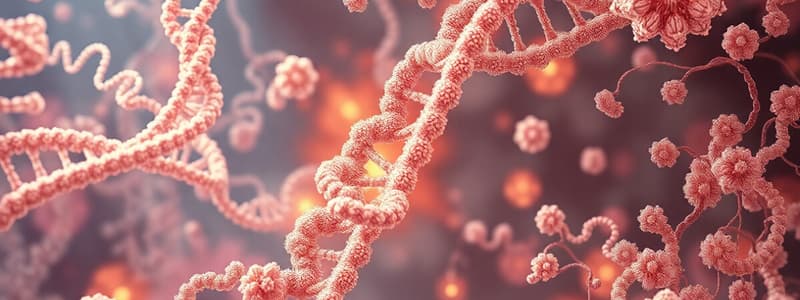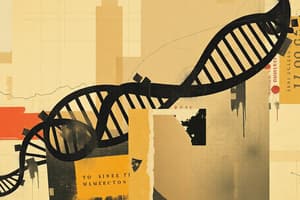Podcast
Questions and Answers
What is the role of tRNA in protein synthesis?
What is the role of tRNA in protein synthesis?
- tRNA carries amino acids to the ribosome. (correct)
- tRNA provides the template for protein synthesis.
- tRNA breaks down the mRNA molecule.
- tRNA helps in the unwinding of DNA during transcription.
During transcription, what happens to the DNA molecule?
During transcription, what happens to the DNA molecule?
- The DNA molecule is completely broken down.
- The DNA molecule is replicated, creating two identical copies.
- Only one strand of DNA is used as a template for mRNA synthesis. (correct)
- The entire DNA molecule is copied to form mRNA.
What is the function of RNA polymerase in transcription?
What is the function of RNA polymerase in transcription?
- RNA polymerase transports mRNA from the nucleus to the ribosome.
- RNA polymerase breaks down the mRNA molecule after transcription.
- RNA polymerase unwinds the DNA molecule and adds nucleotides to the growing mRNA strand. (correct)
- RNA polymerase joins amino acids together to form a polypeptide chain.
What is a codon?
What is a codon?
What is the role of the start codon in translation?
What is the role of the start codon in translation?
Which of the following is NOT a difference between DNA and RNA?
Which of the following is NOT a difference between DNA and RNA?
Where does transcription occur?
Where does transcription occur?
What is the name of the bond that joins amino acids together in a polypeptide chain?
What is the name of the bond that joins amino acids together in a polypeptide chain?
Flashcards
Protein Synthesis
Protein Synthesis
The process of creating proteins from DNA instructions through transcription and translation.
Transcription
Transcription
The process of making mRNA from DNA, occurring in the nucleus.
Translation
Translation
The process of using mRNA to assemble proteins at ribosomes.
Codon
Codon
Signup and view all the flashcards
Anticodon
Anticodon
Signup and view all the flashcards
Start Codon
Start Codon
Signup and view all the flashcards
Stop Codon
Stop Codon
Signup and view all the flashcards
Peptide Bond
Peptide Bond
Signup and view all the flashcards
Study Notes
Protein Synthesis Overview
- Protein synthesis is a two-part process: transcription and translation.
- Transcription takes place in the nucleus.
- Translation occurs at the ribosomes.
- The process ensures the correct protein is made from a DNA strand.
- The process involves contrasting locations and steps of transcription and translation.
- The process contrasts DNA with RNA and their functions.
Transcription
- The process of making mRNA from DNA.
- It takes place inside the nucleus.
- Steps:
- DNA "unzips".
- RNA polymerase breaks hydrogen bonds between base pairs.
- Free-floating RNA nucleotides attach to one side of the DNA molecule.
- Covalent bonds form between the sugars and phosphates on the mRNA strand.
- mRNA is released and the DNA "zips" back up.
- RNA polymerases (enzymes) guide transcription by reading the DNA code.
- DNA and RNA bases pair up:
- A with U
- T with A
- C with G
- G with C
Translation
- Using mRNA to make proteins.
- Occurs at the ribosomes.
- Steps:
- mRNA leaves the nucleus and travels to the ribosome (site of protein synthesis).
- Amino acids are brought to the ribosome by tRNA.
- tRNA bases (anticodons) pair with mRNA bases (codons).
- Amino acids join together by peptide bonds to form a protein (polypeptide).
- Important terms:
- Codon: 3 mRNA nucleotides (or bases).
- Anticodon: 3 tRNA nucleotides (or bases).
- Base pairing: mRNA base | tRNA base
- ------ | -------- A | U U | A C | G G | C
RNA
- There are 3 types: mRNA, tRNA, rRNA.
- mRNA takes the code out to the ribosomes.
- tRNA brings amino acids to the ribosomes to make proteins.
- RNA uses uracil instead of thymine.
- RNA is single-stranded, and DNA is double-stranded.
DNA vs. RNA
- DNA contains thymine, RNA uses uracil instead.
- DNA is double-stranded, RNA is single-stranded.
- DNA contains deoxyribose sugar RNA contains ribose sugar.
- DNA stays in the nucleus, RNA travels between the nucleus and cytoplasm.
Importance of RNA
- mRNA takes the code out to the ribosomes.
- tRNA brings amino acids to the ribosomes to make proteins.
- Information is transferred from DNA to RNA to proteins, this is called the central dogma of molecular biology.
Studying That Suits You
Use AI to generate personalized quizzes and flashcards to suit your learning preferences.




